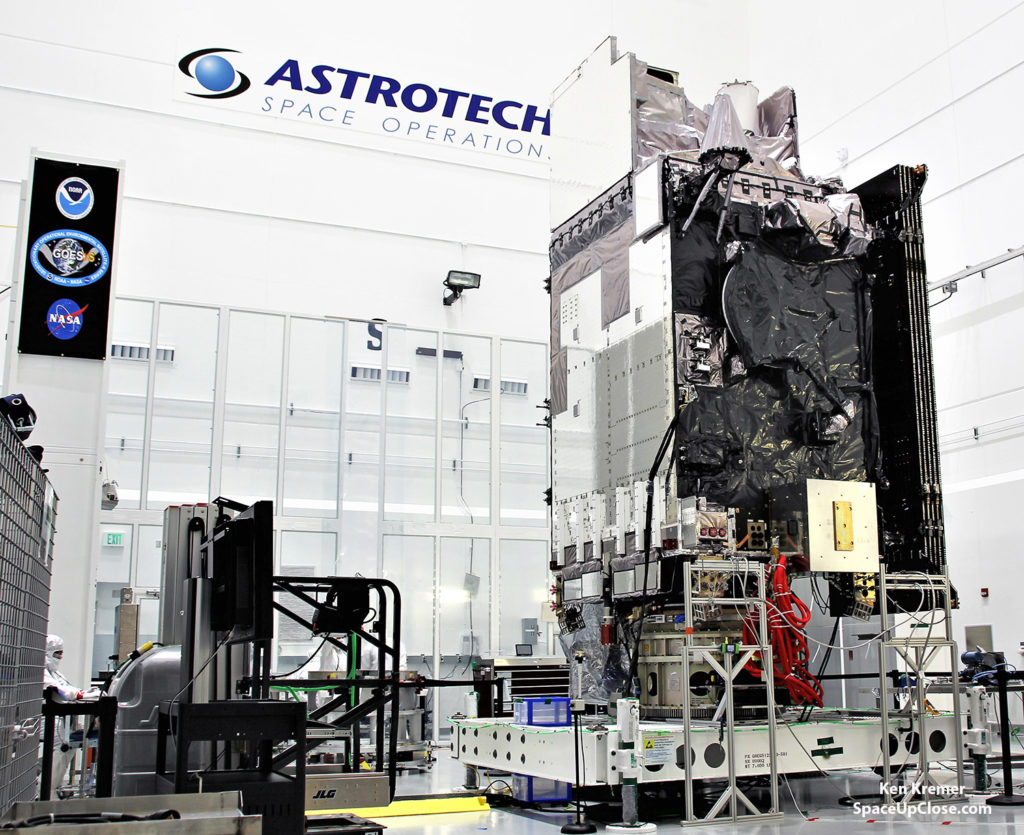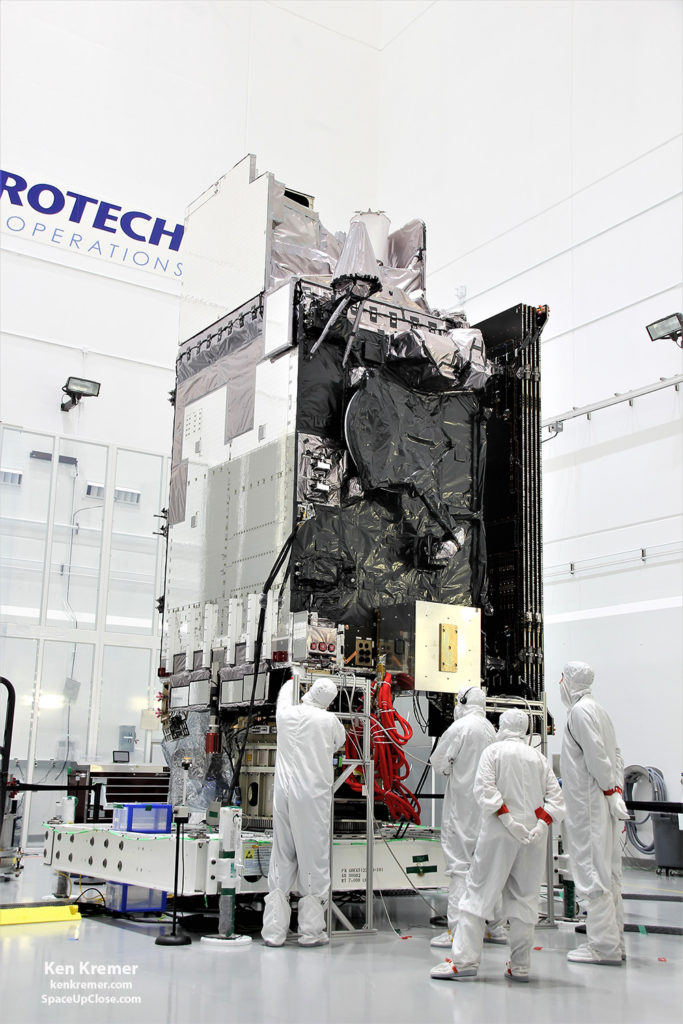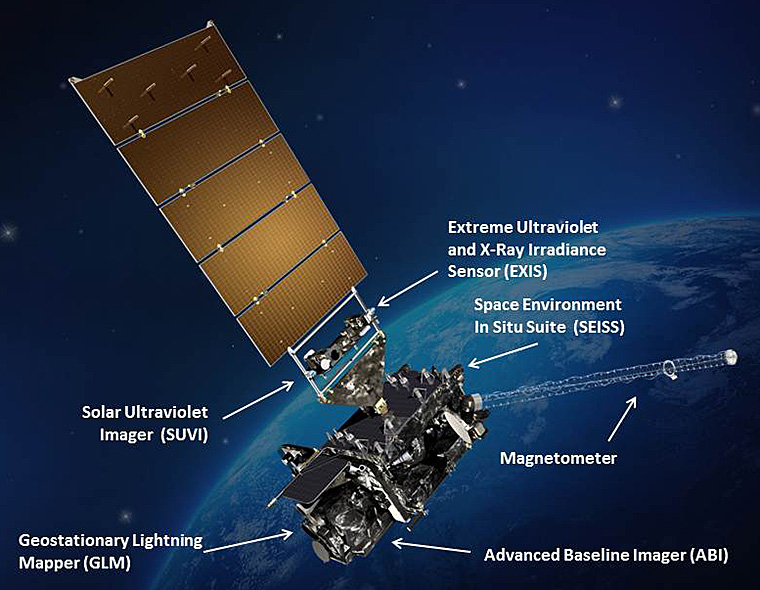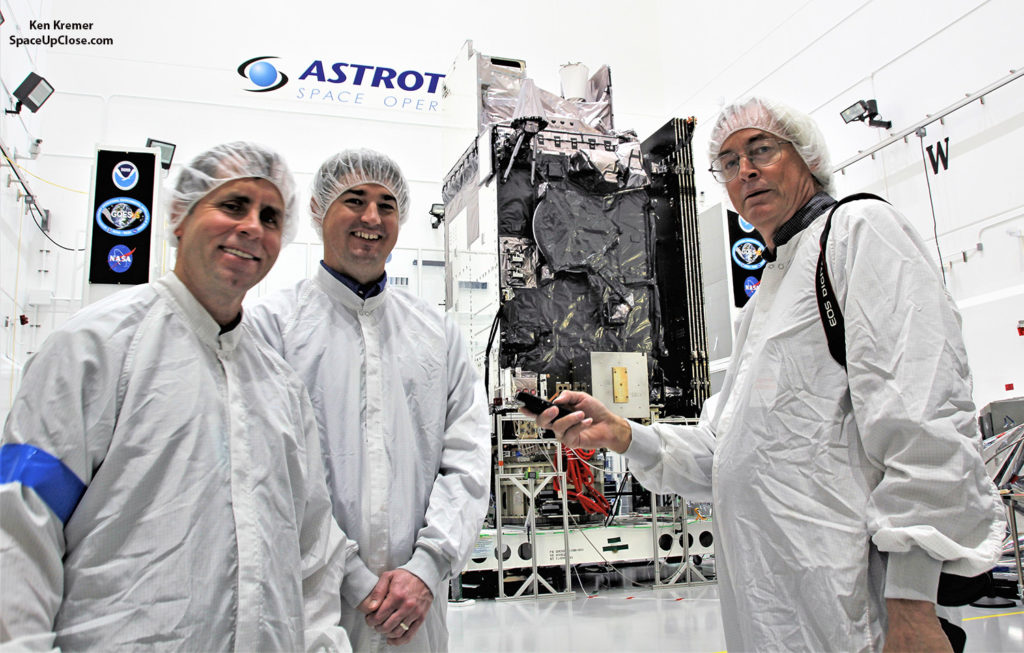 |
|
In the clean room at Astrotech
Space Operations, in Titusville, FL, Tim Walsh, acting GOES-R system program director at NOAA and Dan Lindsey, GOES-R senior scientific advisor at NOAA discuss the advanced weather observation capabilities of NASA/NOAA Geostationary Operational Environmental Satellite-S (GOES-S) with Ken Kremer/SpaceUpClose during satellite processing on Jan. 16, 2018. Launch on Atlas V set for Mar. 1, 2018. Credit: Ken Kremer/SpaceUpClose.com/kenkremer.com |
with 4x better spatial resolution, 3 x as many frequencies or spectral bands,
and we receive images 5 x faster,” Walsh said already with GOES-R/GOES-16 compared
to the legacy GOES East/West satellite imager technologies “which were created
and developed in the mid-1980s.”
current imager on orbit today takes 26 minutes. With GOES-R now we can do the
same thing in 5 minutes.”
now weather forecasting imagery.”
May, said Walsh. “First we need to raise the temperature of the instruments
once on orbit. We will outgas them for several weeks.”
17 and GOES-R/GOES 16.”
they will be located at different positions in the equatorial belt to obtain different
views. Together they will be able to
image the entire US and regions further out beyond to the east and west to
provide coverage of the entire Western Hemisphere.
have from GOES 16.”
the eastern pacific. So at that time we will be able to see the entire United States
out to Hawaii, Alaska and even almost to New Zealand.”
gives the full Eastern seaboard and CONUS [continental US] coverage,” Walsh
explained.
impact?
said Dan Lindsey, acting GOES Chief scientist in the Astrotech cleanroom.
the GLM are such that we can see things smaller that we could not see before. Especially
like fires, which is a big issue up there. Ice coverage of the rivers and the
seas is also a big thing.”
we will have much better resolution and will be able to see smaller fires in California than with the current legacy GOES West.”
even than the test position of GOES-16 or even the legacy systems.”
models and observing ice flows are also big advances offered by GOES-S.
is that is where many of our weather systems come from,” Lindsey explained. “In
general, the flow is from west to east across the country.”
then the better we can do at initializing the weather models. And the models are
what the forecasters use to do their day to day forecasts.”
sense but also quantitate data products that get fed into the models for their
initial conditions. therefore, we get better forecasts.”
Society meeting for the test imagery from
data for ice flows from the high latitudes of the Alaskan and Hudson Bay region,”
Walsh added.
GOES-17 which aren’t visible at all from GOES-16.
tropical cyclones in the eastern Pacific as GOES 16 does for the Atlantic. GOES
16 can see all the way over to the coast of Africa and the formation of the
tropical cyclones and early hurricane formation.”
from the Aleutian Islands in Alaska where we had many eruptions in 2017.”
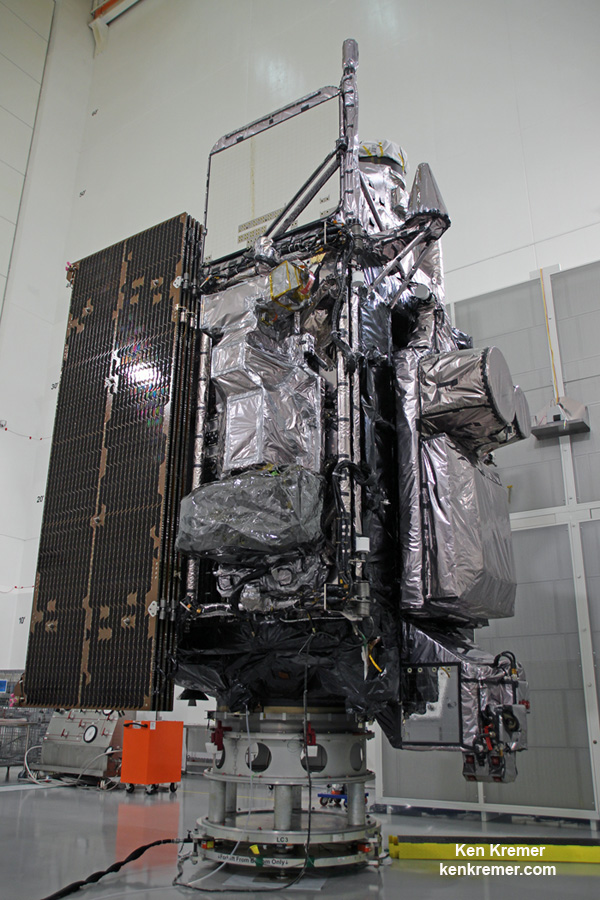 |
| Side view of NASA/NOAA GOES-R next gen weather observation satellite showing solar panels and instruments inside Astrotech Space Operations cleanroom, in Titusville, FL. Credit: Ken Kremer/kenkremer.com/spaceupclose.com |
Program (GOES) system consists of a series of geostationary
weather observation satellites orbiting more than 22,000 miles above Earth developed for the nation as part of a cooperative joint effort between NASA and the National Oceanic and Atmospheric
Administration (NOAA).
GOES-R series of America’s most powerful and most advanced next generation geostationary weather observation
satellites. It is designed to last for a
15 year orbital lifetime and will deliver a ‘quantum leap’ in weather
forecasting.
science suite includes the Advanced Baseline Imager (ABI), Geostationary Lightning Mapper (GLM),
Solar Ultraviolet Imager (SUVI), Extreme Ultraviolet and X-Ray Irradiance
Sensors (EXIS), Space Environment In-Situ Suite (SEISS), and the Magnetometer
(MAG).
operating so far in orbit?
expectations. We are very excited,” Walsh told Space UpClose.
that gets most of the imagery and glory along with the GLM. We started ABI
development in 2001. So its truly 2010s technology development.”
sun, SUVI and EXIS – that’s for Ultraviolet (UV) and extreme UV regions. These
give us a sense of solar activity so that we can make forecasts in case we get
impacted by solar wind or other solar particle hits.”
check for impacts on the spacecraft from the sun, and that’s important for its
impact on for example communications, GPS support, spacecraft and astronauts
operation in Earth orbit.”
different scales. It can look at the full western hemisphere, it can look at
CONUS and it can look at 1000 km x 1000 km mesoscale regions. And those are pretty
important.”
each satellite has the ability to have two of them which can update every
minute. And if we overlap them we can update every 30 seconds.”
season, for example like we saw last fall.”
tornadic activity in the springtime in the Midwest and focus in and try to
predict what’s going on,” said Walsh
before the storms are formed – because you have an environment that is capable
of producing supercell thunderstorms which can in turn produce tornadoes,”
added Lindsey.
cumulous clouds that are trying to form. They get up and get blown over by the shear
and repeat that cycle.”
convective initiation. And after the storms form into actual supercell storms then
the satellite will be used in concert with the radars we have.”
warnings. So this may not revolutionize tornado
warning lead times – but it will help tremendously in the prestorm analysis.”
and their convective outlooks this will help them in evaluating the environment
before the storms are formed and
deciding exactly where and when to place these watches.”
chance of favorable weather conditions for Thursday’s near sunset
blastoff.
ULA, Boeing, Lockheed Martin, Orbital ATK and more space and mission
reports direct from the Kennedy Space Center and Cape Canaveral Air Force
Station, Florida.
Earth and Planetary science and human spaceflight news: www.kenkremer.com –www.spaceupclose.com –
twitter @ken_kremer – ken
at kenkremer.com
weather satellite launch, SpaceX Falcon Heavy
and Falcon 9 SES-16/GovSat-1 launches on Jan. 30 & Feb. 6, NASA missions,
ULA Atlas & Delta launches, SpySats and more at Ken’s upcoming outreach
events at Kennedy Space Center Quality Inn, Titusville, FL:
SpaceX Falcon Heavy & Falcon 9 launches, ULA Atlas USAF SBIRS GEO 4 missile
warning satellite, SpaceX GovSat-1, CRS-14 resupply launches to the ISS, NRO
& USAF Spysats, SLS, Orion, Boeing and SpaceX Commercial crew capsules, ,
OSIRIS-Rex, Juno at Jupiter, InSight Mars lander, Curiosity and Opportunity
explore Mars, NH at Pluto and more,” Kennedy Space Center Quality Inn, Titusville,
FL, evenings. Photos for sale
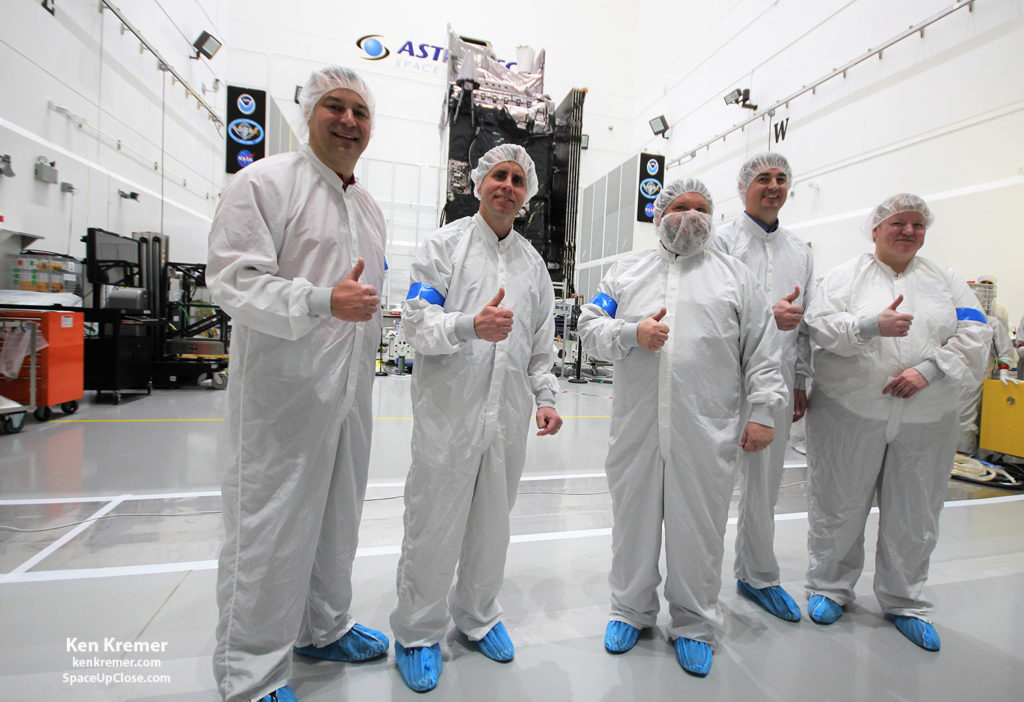 |
|
The NASA/NOAA/Lockheed Martin/Harris
GOES-S team gives a big thumbs up for the dramatic leap in capability this next gen weather observation satellite will provide to the Western US – during media briefing at Astrotech Space Operations, in Titusville, FL on Jan. 16, 2018. Ken Kremer/SpaceUpClose.com/kenkremer.com
|



